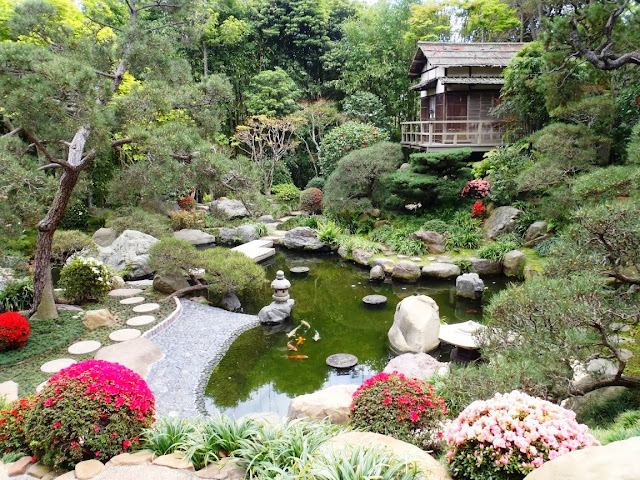The Japanese garden has its origins in China and Korea. Japanese monks who traveled to these countries , brought the art of gardening in Japan. Over the centuries created different styles that are cited today. Since many very old gardens have received in Japan by the consistent care, you can visit in Japan, the whole garden history in many public gardens and understand. Modern Japanese Garden artists draw not only from historical topics such as Zen gardens, pond gardens, convertible, tea gardens, viewing gardens-today there are many modern interpretations or entirely new directions of Japanese garden design, not only in Japan but worldwide.
The main elements of the Japanese garden are: rocks, garden rocks, stones, stone circles, stepping stones, paths, bridges, Nobedan, tobi - ishi, grit, gravel, pebbles, gravel, sand, decorated pine trees (not bonsai), azaleas, o-karikomi, o-tamamono (which are topiaries), sometimes ornamental cherries, plums, ground cover like moss, grasses, bamboo, ferns. Water is present in the pond, koi pond, koi, creek, river, waterfall, fountain , but also as grit surface in a karesansui Garden (meaning dry landscape garden) before or as Pebble creek, dry lake, Tock Bach. Furthermore you will find in the Japanese garden ornamental elements such as Japanese stone lanterns, Japanese water basin, rare pagodas and Buddha. Architectural elements such as gate, fence, fence sleeves, sleeve fences and fences, called gaki, waiting bench or pavilion (machiai, azuma ), tea hut, in the tradition of Sukiya are mostly architecture.
Shukiya features natural materials, which are processed into high-quality craftsmanship, and by certain proportions and parts of buildings, such as over roofs (engawa, engava-this is a narrow terrace that leads around the house) sliding doors, patios (tsubo-niwa).
The Japanese garden style is also characterized by various aesthetic features such as naturalness, asymmetry, reduction, abstraction, spontaneity. All artificiality, Ostensible is avoided in the Japanese Garden-patina as signs of wear, mosses and lichens are estimated in the Japanese Garden ( wabi sabi-). Simple surfaces from debris or ground cover or as a background fences bring the individual garden elements to even better effect and convey calm and clarity. Formal, man -made such as hewn, cut stone, topiaries, such as o-or o-karikomi tamamono are in contrast to natural forms such as a complex delicate maple, acer japonica. The subjects are often Japanese landscapes, which are presented in an abstract (not miniaturized!) Way in japanese garden.
So rich, for example, a fern, a barren bush, a rock and moss in order to create a Waldathmosphäre. The Japanese garden playing with understatement and is more concerned with the natural opposites of light and shadow, surface and volume, inside and outside, and the vicissitudes of the seasons. In the Japanese garden, Japan Garden, it's more about the sensual experience of fine, sensitive perceptions such as trickling water pool, the sound of the bamboo, dew on the ferns, scattered leaves on a moss area, etc. These things you can experience better than in any other garden form of the Japanese garden, because the Japanese garden is made??, exactly for these perceptions and takes this into account in the design. Unfortunately, many misconceptions have been established in the design way of Japanese gardens, which are in our opinion, the Japanese garden art does not do justice.
To build an authentic Japanese garden, you need a lot of expertise and many design tricks. Some of them you can find in our free building instructions to Nobedan, Tsukubai, Yotsume-gaki, yaku-ishi, o- karikomi, tama-mono, soon even the jaw design and other related topics.











0 Response to "Japanese Garden Art"
Post a Comment